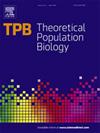适应度效应在适应过程中的动态分布。
IF 1.3
4区 生物学
Q4 ECOLOGY
引用次数: 0
摘要
新突变适应度效应分布(DFE)的实证测量越来越成功,最近强调了DFE在适应过程中发生变化的事实。在这里,我们分析了在一个简化的适应过程中DFE的这些动态变化:在一个附加适应度景观上的自适应行走。首先,我们推导出基因型中存在的等位基因的潜在适应度分布的分析近似,并通过突变获得,并使用这些近似来推导出适应行走每一步的DFE的表达。然后,我们用独立的模拟来证实这些预测,这些模拟放松了分析中做出的几个简化假设。正如预期的那样,我们的分析预测,随着适应的进行,DFE在整个行走过程中通过有益突变比例的减少(向左移动)动态重塑。令人惊讶的是,不同的机制驱动这种变化取决于每个位点可用的等位基因的数量:对于少数可用的等位基因,我们观察到预期的高适应度等位基因通过突变耗尽,然而对于大量的等位基因,我们观察到适应可能更多地受到低适应度等位基因替代的可用性的限制,而不是高适应度等位基因替代它们的可用性。本文章由计算机程序翻译,如有差异,请以英文原文为准。
Dynamics of the distribution of fitness effects during adaptation
Empirical measures of the distribution of fitness effects of new mutations (the DFE) have been increasingly successful, and have recently highlighted the fact that the DFE changes during adaptation. Here, we analyze these dynamic changes to the DFE during a simplified adaptive process: an adaptive walk across an additive fitness landscape. First, we derive analytical approximations for the underlying fitness distributions of alleles present in the genotype and available through mutation and use these to derive expressions for the DFE at each step of the adaptive walk. We then confirm these predictions with independent simulations that relax several simplifying assumptions made in the analysis. As expected, our analysis predicts that as adaptation proceeds, the DFE is reshaped dynamically throughout the walk by a decrease in the beneficial fraction of mutations (a shift to the left). Surprisingly, different mechanisms drive this change depending on the number of alleles available per site: for a small number of available alleles, we observe a depletion of high-fitness alleles available through mutation as expected, however for a large number of alleles we observe that adaptation may be more limited by the availability of low-fitness alleles to be replaced, rather than by the availability of high-fitness alleles to replace them.
求助全文
通过发布文献求助,成功后即可免费获取论文全文。
去求助
来源期刊

Theoretical Population Biology
生物-进化生物学
CiteScore
2.50
自引率
14.30%
发文量
43
审稿时长
6-12 weeks
期刊介绍:
An interdisciplinary journal, Theoretical Population Biology presents articles on theoretical aspects of the biology of populations, particularly in the areas of demography, ecology, epidemiology, evolution, and genetics. Emphasis is on the development of mathematical theory and models that enhance the understanding of biological phenomena.
Articles highlight the motivation and significance of the work for advancing progress in biology, relying on a substantial mathematical effort to obtain biological insight. The journal also presents empirical results and computational and statistical methods directly impinging on theoretical problems in population biology.
 求助内容:
求助内容: 应助结果提醒方式:
应助结果提醒方式:


